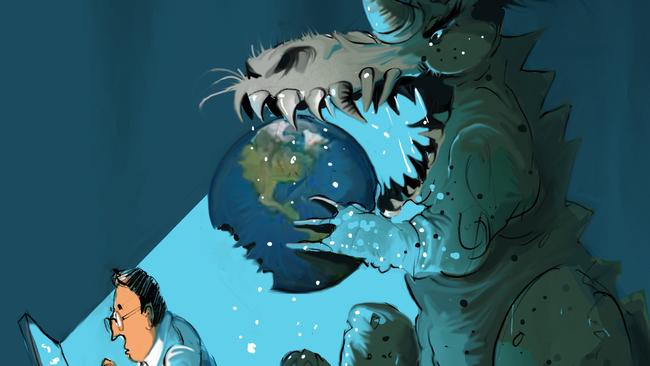
The cost of doing nothing is sending the country broke if we are to believe the fright stats peddled by the City of Sydney council.
“Physical inactivity is a major killer,” chides the council in a news release. “It costs the nation almost $135 billion a year.”
Fiscally retentive readers will have noticed already what an improbable figure that is. It is almost three times larger than the commonwealth’s 2015-16 health budget or, to put it another way, roughly 8 per cent of gross domestic product.
The good news about fright stats, however, is that they seldom turn out to be true.
Fright stats are not empirical measures of the world as it is but blunt instruments fashioned to fight noble causes, in this case Lord Mayor Clover Moore’s plan to tear up Sydney’s arteries of commerce and make everyone ride bikes.
Healthcare isn’t cheap, as Scott Morrison is no doubt discovering as he prepares his first budget. You have to feel sorry for the bloke trying to balance the books with a measly $160bn to spend next year.
Allergic diseases are costing us $30bn a year if we are to believe a report in The New Dailyin August. Inflammatory bowel disease is costing us another $3.1bn, which is a bit of a bummer too. Diabetes is said to cost us $14.6bn; arthritis $2.2bn; back pain $9.9bn; and Parkinson’s disease “almost $10bn”. So far we’ve clocked up more than $200bn on sickness and disease, enough to run the international space station for the next 35 years.
And there’s more. The Huffington Post reported in October that chronic pain affects one in five Australians. The cost to the nation in health, lost productivity and other factors is said to be $34.3bn, more than the nation’s defence budget.
And don’t get the fright statisticians started on health and safety. Safe Work Australia reports that an epidemic of emotional exhaustion, psychological distress and depression is wrecking national productivity.
The cost to the nation of this adverse “psychosocial safety climate” is said to be $32.2bn a year, slightly more than the government’s 2014-15 budget for Medicare and Pharmaceutical Benefits.
Climate change? Just read the headlines. “Extreme heat poses a billion-dollar threat to Australia’s economy” trumpeted The Conversation in May above a report claiming that in 2013-14 heat stress cost the nation $6.9bn.
According to the authors of the report, things are only going to get worse: “Modelling using just the wet bulb globe temperature data suggests that labour productivity in hot countries will decline by up to 20 per cent by 2050 as the climate warms.” Pollution from coal-fired electricity generation is costing us $2.6bn a year, according to the Climate Health Alliance, which claims the figure is “likely a huge underestimate”. Improbably, the alliance reckons that air pollution generally “costs the nation up to $24.3bn in health expenses every year”.
This is economic parody at best, yet journalists insist on treating fright stats seriously. Few have the time, or worse still the inclination, to exercise their curiosity or indulge a healthy scepticism.
No reasonable person would imagine that the health costs caused by air pollution is greater than half the federal government’s health budget.
For those who accept that climate change is the greatest moral and economic challenge of our times, however, questioning these figures would be apostasy.
Fictionomics and churnalism have formed a marriage of convenience. Since the truth, unfortunately, tends to be mundane, the media has adopted “truthiness”, a word coined by Stephen Colbert to describe things that aren’t true but ought to be.
Real statistics, rationally analysed and fairly reported, often present good news in a sophisticated developed nation like Australia. To turn them into fright stats requires torturing them to within an inch of their lives.
Few countries apart from Denmark and the Federated States of Micronesia have roads as safe as Australia, yet “road trauma costs the nation $27bn a year”, the gloom-mongers insist. Traffic congestion in our cities is said to cost $16bn in lost productivity.
Australia is one of the five healthiest countries in the world if we were to judge by the statistics on life expectancy. Yet we’re told that obesity is costing $58.2bn a year and other bad habits are costing us more. Problem gambling is said to be costing $4.7bn plus another $1bn in lost productivity on Melbourne Cup day.
The frequently quoted cost of smoking to the nation is $31bn a year, while drinking costs us $36bn a year, according to the Foundation for Alcohol Research and Education.
The compilers of these reports would be strong contenders for this year’s Ignoble Prize for Fictionomics.
The prize, however, must go to the compilers of a report in Fairfax Media newspapers last month that claimed greater income equality between men and women would help boost the broader economy. How so?
“The current gender pay gap of 17 per cent costs the nation $93bn each year,” the report claims. “Lifting women’s earnings to match men’s was forecast to boost GDP by $56bn, or 5.1 per cent.”
There you have it; pay rises all around — males excepted, of course — will fix gender inequality and sluggish economic growth rates. Why didn’t we think of that before?
Nick Cater is executive director of the Menzies Research Centre.


